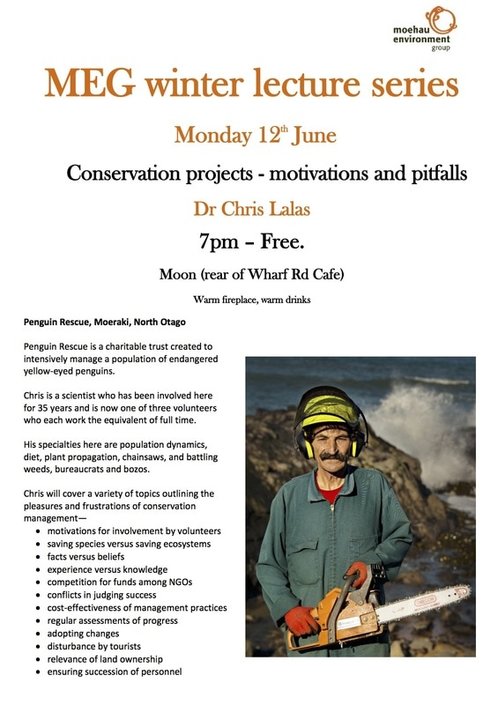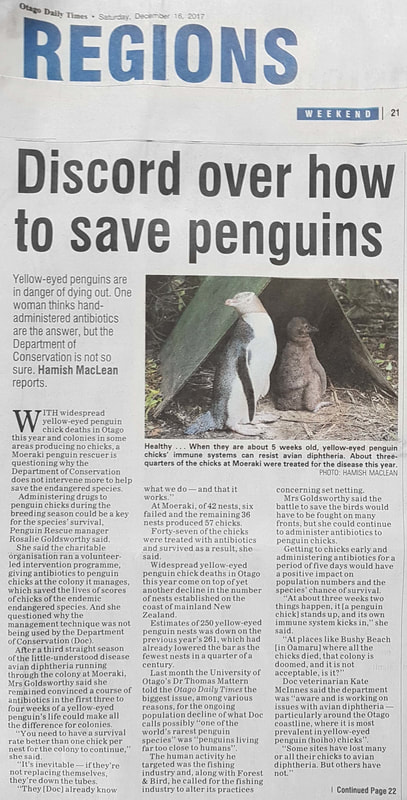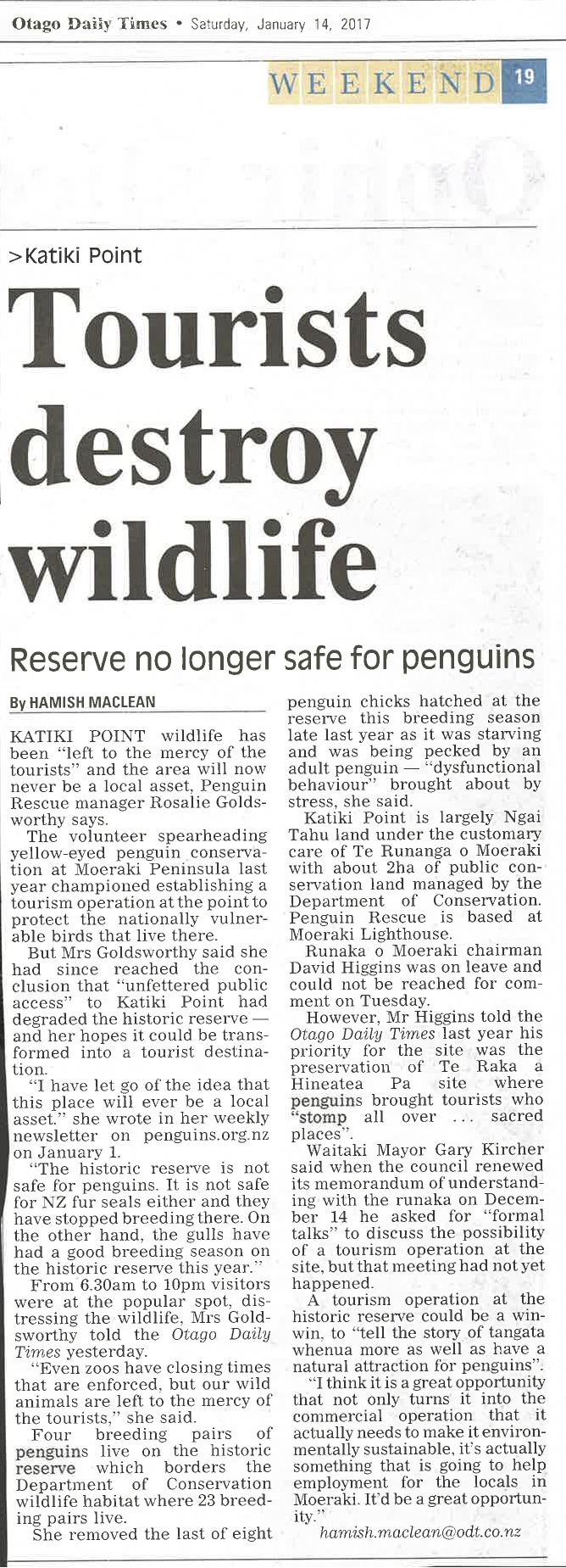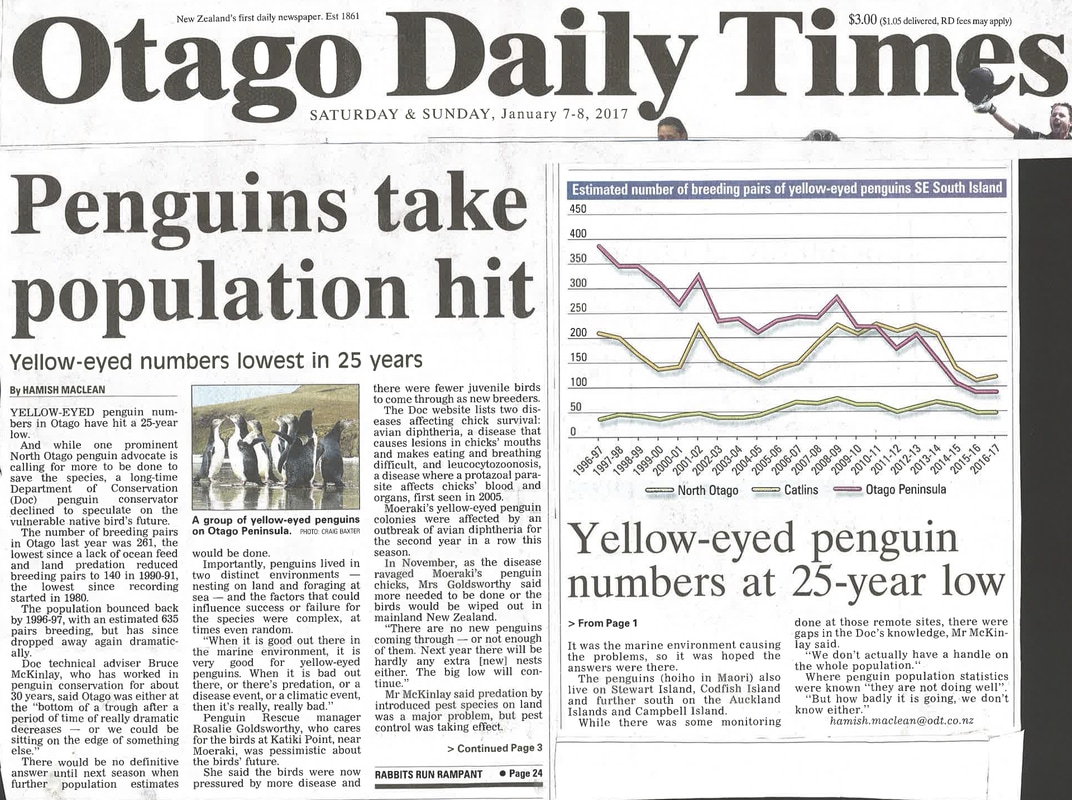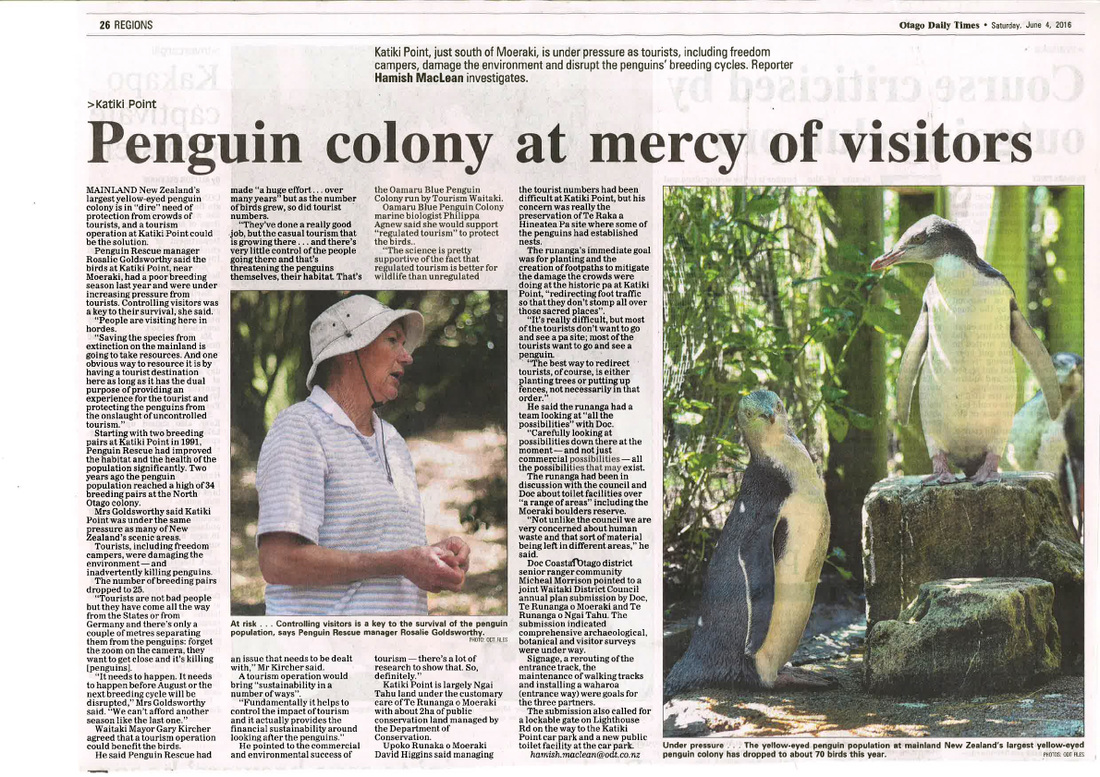Advocacy and annual reports
Our work as a charitable trust is summarised in annual reports. In addition our work is presented at symposia and conferences, and articles are published in newsletters and magazines.
Annual reports
Advocacy and presentations
Annual Report Archives
Yep symposium for season 2020/21
Yep symposium for season 2019/20
10th International Penguin Conference
Yep symposium for season 2018/19
Oamaru penguin conference 2016
MEG winter lecture series: Dr Chris Lalas
Yep symposium for season 2017/18
YEP Symposium for season 2016/17
YEP Symposium for season 2015/16
Yep symposium for season 2014/15
YEP Symposium for season 2013/14
Scientific article: predicting a decline in yellow-eyed penguins
South East marine protection area forum science workshop 2015
15
16
17
18
19
20
21
22
23
24
25
26
27
28
29
30
- Yellow-eyed penguin Symposium 7 August 2021

Download Filepenguin_rescue_2020-21_annual_report_presentation.pdf File Size: 6892 kb File Type: pdf - Yellow-eyed penguin Symposium 1 August 2020

Download Filepenguin_rescue_2019-20_annual_report_presentation.pdf File Size: 14423 kb File Type: pdf - 10th International Penguin Conference 12 - 28 August 2019Restricting penguins instead of people: a mitigation of the impact of uncontrolled visitors on yellow-eyed penguins
Rosalie Goldsworthy, Hiltrun Ratz, Chris Lalas
Penguin Rescue, Katiki Point Lighthouse, RD2 Palmerston, Otago 9482, New Zealand
rosaliegoldsworthy@gmail.com
Abstract
Katiki Point is a c.10ha reserve at North Otago, South Island, New Zealand, jointly administered by the Department of Conservation (DOC) and Ngai Tahu, indigenous owners of most of the reserve. This headland had unrestricted public access and no penguins when founders of Penguin Rescue began conservation management of local seabirds in 1982. We created a breeding colony of yellow-eyed penguins (Megadyptes antipodes) initiated by rehabilitated birds in 1991. Nest numbers have risen and fluctuated from an initial two nests to a peak of 34 nests in 2014, finishing with 23 nests in 2018 at an overall deterministic average annual increase of 9% through 28 years. Visitor numbers exceeded 10,000 annually through the last decade, an influx attributable to accolades in TripAdvisor extoling free close-up viewing of penguins. A substantial impact was first recorded in 2014 with a drastic reduction in penguin breeding success. This affected pairs with nests or with access routes from the sea within 10m of visitor paths. Following a DOC recommendation an internal fence was built reducing the proximity of people to penguin that decreased the available breeding habitat for penguins by c.40%. The administrators of the reserve further mitigated disturbance by realigning public paths away from most nests and by closing access overnight. However, the impacts persist and require ongoing mitigation, an unacceptable outcome for the future of this colony that accounts for 10% of the South Island population. Here an endangered species has been compromised in favour of free public viewing.Rehabilitation as a management tool to enhance population size of yellow-eyed penguins
Hiltrun Ratz, Janice Jones, Rosalie Goldsworthy, Chris Lalas
Penguin Rescue, Katiki Point Lighthouse, RD2 Palmerston, Otago 9482, New Zealand
penguins@xtra.co.nz
Numbers of yellow-eyed penguins (Megadyptes antipodes) are decreasing at south-eastern South Island, New Zealand, with a high risk of extirpation within decades. Published records for annual nest numbers 1982−2015 showed large fluctuations; beginning at 453, peaking at 642 in 1996 and ending at 256 nests. This equated to an overall deterministic average annual decrease of 2% through the 34 years. Intensive management at Moeraki, North Otago, by Penguin Rescue through the same period began at six nests (1% total), peaked at 58 in 2013 and 2014 and ended at 46 nests (18% total), at an overall deterministic average annual increase of 6%. Rehabilitation of compromised penguins began at Moeraki in 1984. We will calculate the minimum impact of rehabilitation on the Moeraki population in 2018 not only by subtracting any breeding that followed rehabilitation of marked female juveniles or adults but also by subtracting any breeding by their female descendants. Just now we have comprehensive results only to 2006, by which time 14 females nested at Moeraki after rehabilitation (and another four nested elsewhere). The 43 nests at Moeraki in 2006 included six (14%) rehabilitated marked females and seven of their female descendants: their subtraction reduced number of nests by 30% to 30 nests. Techniques have evolved throughout the rehabilitation process and will be expressed as increases in female breeder survival and increased female recruitment; e.g. through the most recent four years, an average 53% of female breeders and a total 60% of female recruits had been previously rehabilitated.Prey switching by yellow-eyed penguins attributable to recreational over-fishing?
Chris Lalas, Hiltrun Ratz
Penguin Rescue, Katiki Point Lighthouse, RD2 Palmerston, Otago 9482, New Zealand
ithaki@xtra.co.nz
Blue cod (Parapercis colias) is the most important marine recreational fishing species around South Island, New Zealand. It accounts for 63% of the recreational catch at North Otago where published surveys found increases in undersized cod caught (16–30cm), 50% in 2005 and 41% in 2011. Increased abundance of small cod was attributed to fishing pressure. Previous diet studies on yellow-eyed penguins (Megadyptes antipodes) 40–50km further south at Otago Peninsula found blue cod numerically accounted for 1% of prey in 1984–86 and 2% of prey in 1991–94 from flushed stomachs, and 24% in 2016 from penguin-borne cameras. The likelihood of an increased importance of blue cod in the penguin diet through time is further supported at Moeraki, North Otago, where 159 cod (average=21cm, range=8–31cm) accounted for 48% of prey represented in 83% of 47 adult casts in the 2014 season. Timing of the prey switch to blue cod was deduced from analysis of the contents of food spilt when adults feed chicks. We systematically collected spills from Otago Peninsula through 16 seasons, 1997–2012, then from Moeraki through five seasons, 2014–2018. Blue cod remains occurred in 66% of 290 spills, with calculated length remaining similar through time (262 fish, average=22cm, range=9–30cm). A logistic model indicated increase in average occurrence of cod in spills from 29% in 1997 to an asymptote of 69% since 2006. Implications of this prey switch extend beyond penguin biology to include fisheries interactions and penguins as a pariah for fishers. - Yellow-eyed penguin Symposium 4 August 2019

Download Filepenguin_rescue_2018-19_annual_report_presentation.pdf File Size: 2151 kb File Type: pdf - Yellow-eyed penguin Symposium 5 August 2017

Download Filepenguinrescue_2016-17.pdf File Size: 8793 kb File Type: pdf 
Download Fileoamaru_penguin_conference_abstract_may2016.pdf File Size: 51 kb File Type: pdf - Yellow-eyed penguin Symposium 4 August 2018

Download Filepenguin_rescue_2017-18_annual_report_presentation.pdf File Size: 1770 kb File Type: pdf - Yellow-eyed penguin Symposium
5 August 2017
Download Filepenguin_rescue_2016-17_annual_report_presentation.pdf File Size: 8793 kb File Type: pdf 
Download Filechrislalas-rehab-presentation-yeptsymposium-05aug17.pdf File Size: 4850 kb File Type: pdf - Yellow-eyed penguin Symposium
6 August 2016
Download Fileannualreport_penguinrescue_yepsymposium2016.pdf File Size: 8717 kb File Type: pdf 
Download Filepenguin_habitat_yepsymposium2016.pdf File Size: 3061 kb File Type: pdf - Yellow-eyed penguin Symposium 1 August 2015

Download Filepenguin_rescue_2014-15_annual_report_presentation.pdf File Size: 3013 kb File Type: pdf - Yellow-eyed penguin Symposium
2 August 2014
Download Filepenguin_rescue_rehab_presentation_2013-14_season.pdf File Size: 32796 kb File Type: pdf - A paucity of females – predicting a continued decline in yellow-eyed penguins
Hiltrun Ratz, Chris Lalas, Rosalie Goldsworthy
Abstract
Yellow-eyed penguins, Megadyptes antipodes, are listed in the IUCN Red List as endangered and their numbers have declined in the three key mainland breeding sites through the last four years: Moeraki, (North Otago), Boulder Beach (Otago Peninsula) and Long Point (Catlins). We compared the demography of resident yellow-eyed penguins at Moeraki in 2015/16 with that presented from 10 years of data by L. E. Richdale in A population study of penguins (1957). The key indications of a decline in a population is that the proportion of the population breeding increases as recruitment decreases, and the proportion of females decreases due to a sex-bias in survival. Breeders represented 71% of the resident population at Moeraki compared with 61% in Richdale’s study. Females available for recruitment accounted for 5% of the population at Moeraki, less than half the 11% reported by Richdale. Without a more substantial reservoir of females available for recruitment there will be no fast recovery of the population. Application of average values for survival and recruitment predict a 2% annual increase in nest numbers from the demography generated by Richdale but a 9% annual decrease from the recent demography at Moeraki. We also predict a decrease in breeding success due to increasing interference by surplus males. These predictions are possible only because the Moeraki population is marked and closely monitored throughout the breeding season and subsequent moult. - South-eastern Marine Protection Area Forum Science Workshop 17 April 2015

Download Filemarine_protection_forum_april_2015.pdf File Size: 1445 kb File Type: pdf
Articles
Discord over how to save penguins ODT 16.12.17
Everybody needs to help save the Hoiho ODT 19.12.17
Juvenile survival and lonely male penguins 11.03.17 ODT
Boom year for young penguin population 15.03.17 ODT
Katiki Pt disturbance 14.1.17 ODT
YEP otago population in decline 7.6.17 ODT
Rabbits run rampant 7.6.17 ODT
Traps helping liberate penguins 17.9.16 ODT
Penguins at mercy of visitors 4.6.16
Plight of the YEP 19.12.15
Lure reel news April 2015
12
13
14
15
16
17
18
19
20
21
22
23
24
25
26
27
28
29
30
- OTAGO DAILY TIMES
The ODT featured an article on 11 March 2017 about juvenile yellow-eyed penguins returning for their annual moult: hope for the future of the colony with some of these 1-year olds hopefully starting to breed in 6 months time.
A second article on the same day talked about the problems that a surplus of adult males can cause in a colony.
Download Fileyep-odt_juvenile_survival_and_lonely_males_11mar17.pdf File Size: 488 kb File Type: pdf - OTAGO DAILY TIMES
The ODT featured an article on 14 January 2017 about the tourist impact on the yellow-eyed penguins at Katiki Point.
Download Fileyep-katikipt-disturbance-odt-14jan17.pdf File Size: 253 kb File Type: pdf - OTAGO DAILY TIMES
The ODT featured an article on 7 January 2017 on the decline of yellow-eyed penguins.
Download Fileyep-otago-population-decrease-odt-07jan17.pdf File Size: 243 kb File Type: pdf - OTAGO DAILY TIMES
The ODT featured an article on 7 January 2017 about rabbit numbers and thistles at Katiki Point.
Download Fileyep-katikipt-rabbits-odt-07jan17.pdf File Size: 152 kb File Type: pdf - OTAGO DAILY TIMES
The ODT featured an article on 17 September 2016 on Te Runanga o Moeraki member and conservationist Nola Tipa trapping for introduced predators at Katiki Point.
Download Fileyep-odt_nolatipa_17sept16.pdf File Size: 412 kb File Type: pdf - OTAGO DAILY TIMES
The ODT featured an article on Penguin Rescue on 4 June 2016 highlighting the uncontrolled tourist impact on the penguins at Katiki Point.
Download Fileyep-katiki-visitor-disturbance-odt04jun16.pdf File Size: 926 kb File Type: pdf - OTAGO DAILY TIMES
A recent article in the Otago Daily Times featured Penguin Rescue work (19 December 2015):
http://www.odt.co.nz/regions/north-otago/367426/plight-yellow-eyed-penguin
Download Fileyep-penguinrescue-katikipt-odt-19dec15.pdf File Size: 5085 kb File Type: pdf - LURE - Reel News from the Tautuku Fishing Club
March & April 2015 - Issue 47
Download Filelure_newsletter_-_march+april_2015-prarticle.pdf File Size: 5150 kb File Type: pdf



